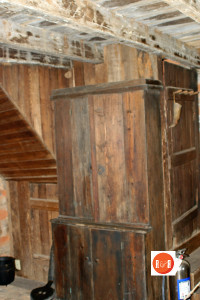“An important historic hall and parlor house in the S.C. upcountry.”
City Directories and History: The Walnut Grove house, outbuildings, and furnishings provide a fully documented picture of life, and an example of social history, in upcountry South Carolina prior to 1830. The house itself is considered one of the finest remaining upcountry plantation houses of the period. Built about 1765 by Charles Moore, a Scotch-Irish immigrant who had moved from the Middle Atlantic colonies into Piedmont South Carolina, the Walnut Grove Plantation house reflects the Scotch-Irish flow of immigration down into the Carolina upcountry, as opposed to the upward flow from the Carolina coast. Its plan and construction are in part indigenous to the Piedmont, in

Walnut Grove Plantation

Walnut Grove Plantation
part influenced by rural Pennsylvania Dutch architecture. Of simple Georgian style, the two-story structure is of un-chinked logs covered with clapboards. Late Queen Anne mantels, fielded paneling, and double-shouldered chimneys are among its distinctive features. Separate outbuildings include a kitchen, built about 1777, and an academy building that doubled as a weaving room. The Rocky Spring Academy at Walnut Grove was established by Moore, one of two classical schools in the county, operating from 1770-1850. Other separate log buildings reconstructed as part of the plantation complex include a well and spring house, a workshop, a smoke house, and a blacksmith shop and forge. About 500 yards west of the main house is the Moore family cemetery. The plantation name came from the walnut trees planted around the house. Listed in the National Register July 1, 1970.
View the complete text of the nomination form for this National Register property(Courtesy of South Carolina Department of Archives and History)
“Nearby is Walnut Grove built 1765 by Charles Moore, a Scotch-Irish settler who came from the Middle Atlantic colonies into Piedmont South Carolina. Of simple Georgian style, the two-story structure is of un-chinked logs covered with clapboards, the-house, furnishings, and outbuildings combining to provide a well documented picture of life in upcountry South Carolina prior to 1830. Walnut Grove also is historically interesting through its connections with the Revolutionary War, and such names as Captain Andrew Barry and his wife Kate, General Thomas Moore, General Daniel Morgan, Banastre Tarleton, Bloody Bill Cunningham.
Information from: Names in South Carolina by C.H. Neuffer, Published by the S.C. Dept. of English, USC
R&R NOTE: The stone gate pillars found at Walnut Grove Plantation deserve a complete explanation as to their history. In Our Father’s Fields by James Kibler, p. 223 writes, “This carving (from Renwick’s Orange Hall house), was done by a talented stonecutter, J.E. Sherman. The gates were removed in 1929 and taken to Pine Street in Spartanburg. In the 1970s Frank Coleman….. positioned them at the present entrance to Walnut Grove.”
Stay Connected
Explore history, houses, and stories across S.C. Your membership provides you with updates on regional topics, information on historic research, preservation, and monthly feature articles. But remember R&R wants to hear from you and assist in preserving your own family genealogy and memorabilia.
Visit the Southern Queries – Forum to receive assistance in answering questions, discuss genealogy, and enjoy exploring preservation topics with other members. Also listed are several history and genealogical researchers for hire.
User comments welcome — post at the bottom of this page.

Sloan – Epton’s Spartanburg Co Map ca. 1869. Courtesy of the Cobb Collection – Other Side of the River Museum, 2016
Please enjoy this structure and all those listed in Roots and Recall. But remember each is private property. So view them from a distance or from a public area such as the sidewalk or public road.
Do you have information to share and preserve? Family, school, church, or other older photos and stories are welcome. Send them digitally through the “Share Your Story” link, so they too might be posted on Roots and Recall.
Thanks!
IMAGE GALLERY

Walnut Grove Plantation – Images courtesy of the Segars Collection








User comments always welcome - please post at the bottom of this page.























Share Your Comments & Feedback: